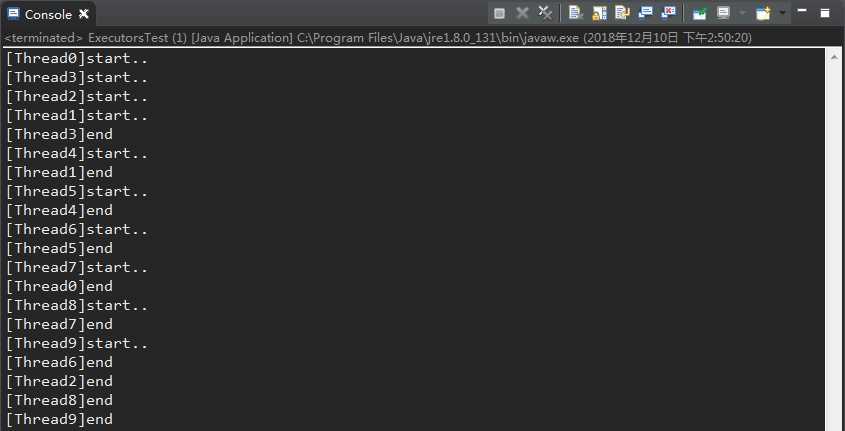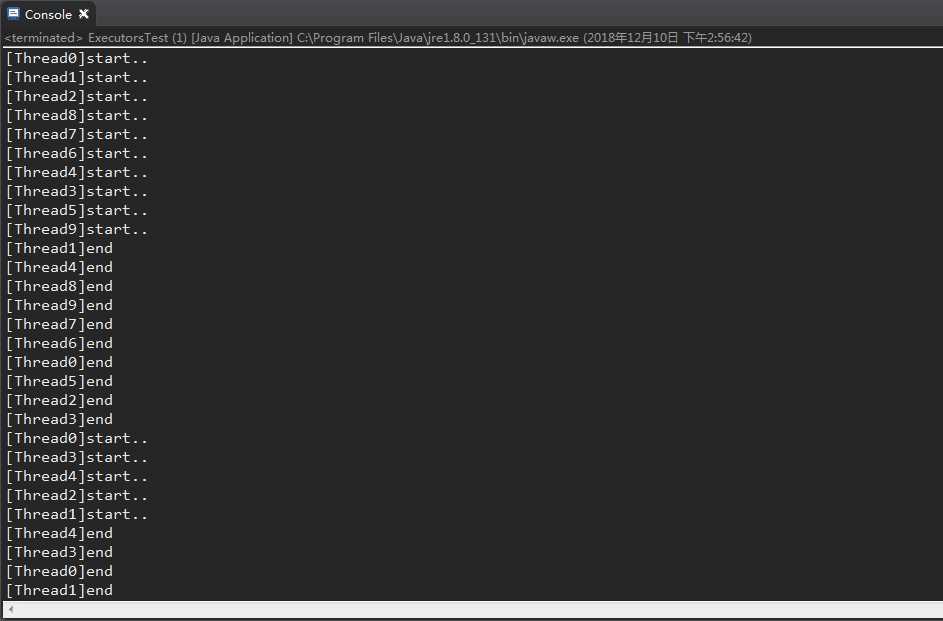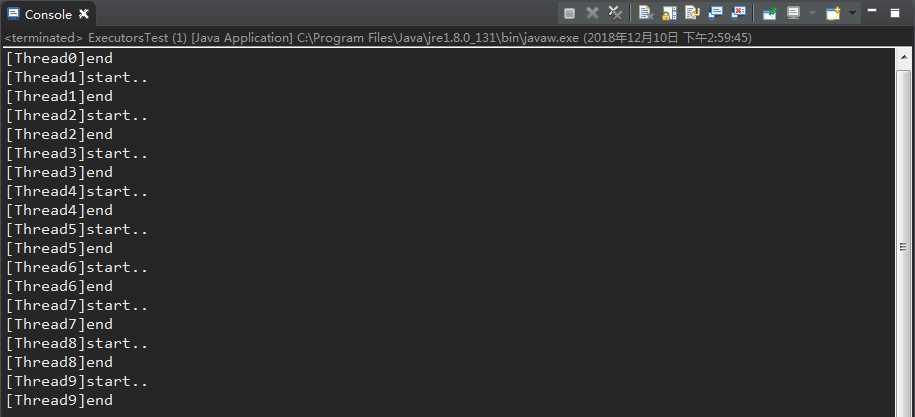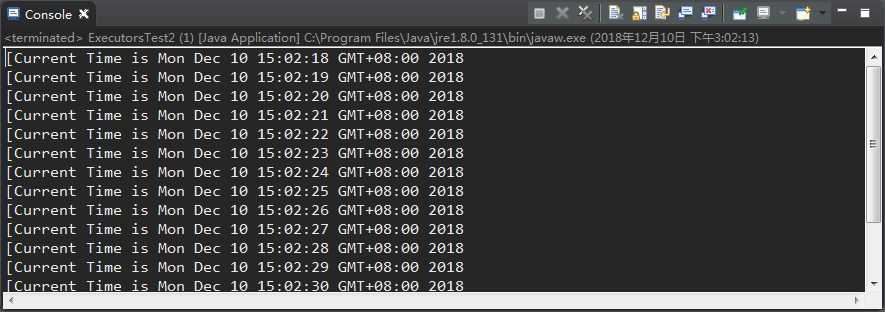标签:long shu Fix 不同的 队列 span 进入 多个 com

java.util.concurrent包下的Executors工厂类,提供了一系列的线程池的创建方法,其构造方法如下:
public ThreadPoolExecutor(int corePoolSize, //线程池线程核心数量,线程池维护线程的最少数量 int maximumPoolSize, //线程池最大线程数量 long keepAliveTime, //空闲线程存活时间 TimeUnit unit, //存活时间的时间单位 BlockingQueue<Runnable> workQueue, //存储任务的线程队列 ThreadFactory threadFactory, //线程工厂 RejectedExecutionHandler handler) { //拒绝策略 if (corePoolSize < 0 || maximumPoolSize <= 0 || maximumPoolSize < corePoolSize || keepAliveTime < 0) throw new IllegalArgumentException(); if (workQueue == null || threadFactory == null || handler == null) throw new NullPointerException(); this.corePoolSize = corePoolSize; this.maximumPoolSize = maximumPoolSize; this.workQueue = workQueue; this.keepAliveTime = unit.toNanos(keepAliveTime); this.threadFactory = threadFactory; this.handler = handler; }
其中常用的线程池有四种,分别是fixedThreadPool、cachedThreadPool、ScheduledThreadPool和SingleThreadExecutor。他们分别适用在不同的场合。
特点:
构造方法:
public static ExecutorService newFixedThreadPool(int nThreads) { return new ThreadPoolExecutor(nThreads, nThreads, 0L, TimeUnit.MILLISECONDS, new LinkedBlockingQueue<Runnable>()); }
实例代码:
import java.util.concurrent.ExecutorService; import java.util.concurrent.Executors; import org.junit.Test; public class ExecutorsTest extends Thread{ private int index; public ExecutorsTest(int i) { this.index = i; } public void run() { try { System.out.println("[Thread"+this.index+"]" +"start.."); Thread.sleep((int)(Math.random()*10000)); System.out.println("[Thread"+this.index+"]" + "end"); }catch(Exception e) { e.printStackTrace(); } } public static void main(String args[]) { ExecutorService service = Executors.newFixedThreadPool(4); for(int i=0;i<10;i++) { service.execute(new ExecutorsTest(i)); } service.shutdown(); } }

因为线程池中线程数量一共有4个,所以当一次有大于4个的任务需要执行时,因为线程池中无空闲线程,后续任务进入等待状态,当其他任务执行完毕后,线程空闲,则马上开始执行正在等待的任务。
特点:
构造函数:
public static ExecutorService newCachedThreadPool() { return new ThreadPoolExecutor(0, Integer.MAX_VALUE, 60L, TimeUnit.SECONDS, new SynchronousQueue<Runnable>()); }
示例代码:
1 import java.util.concurrent.ExecutorService; 2 import java.util.concurrent.Executors; 3 4 import org.junit.Test; 5 6 public class ExecutorsTest extends Thread{ 7 private int index; 8 public ExecutorsTest(int i) 9 { 10 this.index = i; 11 } 12 13 public void run() 14 { 15 try 16 { 17 System.out.println("[Thread"+this.index+"]" +"start.."); 18 Thread.sleep((int)(Math.random()*1000)); 19 System.out.println("[Thread"+this.index+"]" + "end"); 20 }catch(Exception e) 21 { 22 e.printStackTrace(); 23 } 24 } 25 26 27 28 public static void main(String args[]) 29 { 30 ExecutorService service = Executors.newCachedThreadPool(); 31 32 for(int i=0;i<10;i++) 33 { 34 service.execute(new ExecutorsTest(i)); 35 } 36 try { 37 Thread.sleep(1000); 38 } catch (InterruptedException e) { 39 // TODO Auto-generated catch block 40 e.printStackTrace(); 41 } 42 43 for(int i=0;i<5;i++) 44 { 45 service.execute(new ExecutorsTest(i)); 46 } 47 48 service.shutdown(); 49 50 }

创建10个工作线程用于处理任务,当线程执行完毕后,处于空闲状态,此时若出现新的任务,则会从线程池中用空闲的线程来处理新的任务。若没有空闲线程,则开启新线程处理。
特点:
构造方法:
public static ExecutorService newSingleThreadExecutor() { return new FinalizableDelegatedExecutorService (new ThreadPoolExecutor(1, 1, 0L, TimeUnit.MILLISECONDS, new LinkedBlockingQueue<Runnable>())); }
实例代码:
import java.util.concurrent.ExecutorService; import java.util.concurrent.Executors; import org.junit.Test; public class ExecutorsTest extends Thread{ private int index; public ExecutorsTest(int i) { this.index = i; } public void run() { try { System.out.println("[Thread"+this.index+"]" +"start.."); Thread.sleep((int)(Math.random()*1000)); System.out.println("[Thread"+this.index+"]" + "end"); }catch(Exception e) { e.printStackTrace(); } } public static void main(String args[]) { ExecutorService service = Executors.newSingleThreadExecutor(); for(int i=0;i<10;i++) { service.execute(new ExecutorsTest(i)); } service.shutdown(); } }

出现多个任务时,SingleThreadExecutor会按照顺序依次执行各个任务。
特点:
构造方法:
public static ScheduledExecutorService newScheduledThreadPool(int corePoolSize) { return new ScheduledThreadPoolExecutor(corePoolSize); } public ScheduledThreadPoolExecutor(int corePoolSize) { super(corePoolSize, Integer.MAX_VALUE, 0, NANOSECONDS, new DelayedWorkQueue()); }
实例代码一(scheduleAtFixedRate的使用):
import java.util.Date; import java.util.concurrent.Executors; import java.util.concurrent.ScheduledExecutorService; import java.util.concurrent.TimeUnit; public class ExecutorsTest2 extends Thread{ private int index; public ExecutorsTest2() { } public void run() { try { System.out.println("[Current Time is "+new Date().toString()); }catch(Exception e) { e.printStackTrace(); } } public static void main(String args[]) { /* * 执行定时任务newScheduledThreadPool */ ScheduledExecutorService service = Executors.newScheduledThreadPool(10); //5秒后开始执行,每隔一秒执行一次 service.scheduleAtFixedRate(new ExecutorsTest2(), 5, 1, TimeUnit.SECONDS); } }

scheduleAtFixedRate方法,一共四个参数,分别是:需要执行的任务task、延迟执行时间t1、每次执行任务的时间间隔t2、时间间隔单位。
含义是:在t1时间过后,以 1次/t2 的频率来不断执行 task。
上述代码中,在5秒延迟后,以 1次/1秒的频率执行 打印当前时间的任务。
实例代码二(scheduleWithFixedDelay的使用):
1 import java.util.Date; 2 import java.util.concurrent.Executors; 3 import java.util.concurrent.ScheduledExecutorService; 4 import java.util.concurrent.TimeUnit; 5 6 public class ExecutorsTest3 extends Thread{ 7 private int index; 8 public ExecutorsTest3() 9 { 10 } 11 12 public void run() 13 { 14 try 15 { 16 //每次任务大约耗时1秒 17 Thread.sleep(1000); 18 System.out.println("[Current Time is "+new Date().toString()); 19 20 }catch(Exception e) 21 { 22 e.printStackTrace(); 23 } 24 } 25 26 public static void main(String args[]) 27 { 28 /* 29 * 执行定时任务newScheduledThreadPool 30 */ 31 ScheduledExecutorService service = Executors.newScheduledThreadPool(10); 32 33 //5秒后开始执行,每次任务执行完后延迟3秒后,继续执行下一次 34 service.scheduleWithFixedDelay(new ExecutorsTest3(), 5, 3, TimeUnit.SECONDS); 35 } 36 }

scheduleWithFixedDelay也是四个参数,分别是:待执行的任务Task,延迟时间t1,每次任务执行完毕后延迟t2秒后执行下次任务,延迟时间单位。
标签:long shu Fix 不同的 队列 span 进入 多个 com
原文地址:https://www.cnblogs.com/LearnAndGet/p/10096660.html